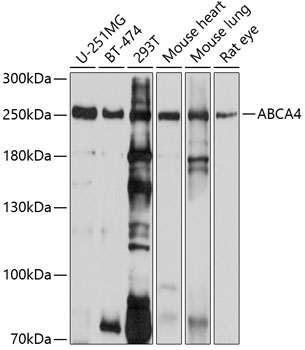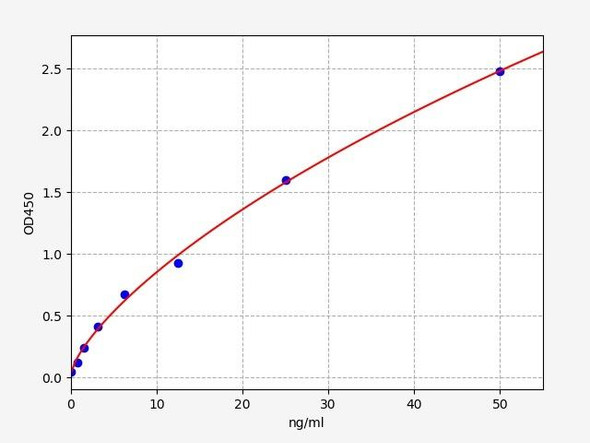Signal Transduction Antibodies 1
Anti-ABCA4 Antibody (CAB10556)
- SKU:
- CAB10556
- Product Type:
- Antibody
- Reactivity:
- Human
- Reactivity:
- Mouse
- Reactivity:
- Rat
- Host Species:
- Rabbit
- Isotype:
- IgG
- Antibody Type:
- Polyclonal Antibody
- Research Area:
- Signal Transduction
Description
| Antibody Name: | Anti-ABCA4 Antibody |
| Antibody SKU: | CAB10556 |
| Antibody Size: | 20uL, 50uL, 100uL |
| Application: | WB IF |
| Reactivity: | Human, Mouse, Rat |
| Host Species: | Rabbit |
| Immunogen: | Recombinant fusion protein containing a sequence corresponding to amino acids 110-300 of human ABCA4 (NP_000341.2). |
| Application: | WB IF |
| Recommended Dilution: | WB 1:1000 - 1:2000 IF 1:50 - 1:200 |
| Reactivity: | Human, Mouse, Rat |
| Positive Samples: | U-251MG, BT-474, 293T, Mouse heart, Mouse lung, Rat eye |
| Immunogen: | Recombinant fusion protein containing a sequence corresponding to amino acids 110-300 of human ABCA4 (NP_000341.2). |
| Purification Method: | Affinity purification |
| Storage Buffer: | Store at -20'C. Avoid freeze / thaw cycles. Buffer: PBS with 0.02% sodium azide, 50% glycerol, pH7.3. |
| Isotype: | IgG |
| Sequence: | QELL MNAP ESQH LGRI WTEL HILS QFMD TLRT HPER IAGR GIRI RDIL KDEE TLTL FLIK NIGL SDSV VYLL INSQ VRPE QFAH GVPD LALK DIAC SEAL LERF IIFS QRRG AKTV RYAL CSLS QGTL QWIE DTLY ANVD FFKL FRVL PTLL DSRS QGIN LRSW GGIL SDMS PRIQ EFIH RPSM QDLL WVT |
| Gene ID: | 24 |
| Uniprot: | P78363 |
| Cellular Location: | Membrane, Multi-pass membrane protein |
| Calculated MW: | 255kDa |
| Observed MW: | 256kDa |
| Synonyms: | ABCA4, ABC10, ABCR, ARMD2, CORD3, FFM, RMP, RP19, STGD, STGD1 |
| Background: | The membrane-associated protein encoded by this gene is a member of the superfamily of ATP-binding cassette (ABC) transporters. ABC proteins transport various molecules across extra- and intracellular membranes. ABC genes are divided into seven distinct subfamilies (ABC1, MDR/TAP, MRP, ALD, OABP, GCN20, White). This protein is a member of the ABC1 subfamily. Members of the ABC1 subfamily comprise the only major ABC subfamily found exclusively in multicellular eukaryotes. This protein is a retina-specific ABC transporter with N-retinylidene-PE as a substrate. It is expressed exclusively in retina photoreceptor cells, indicating the gene product mediates transport of an essental molecule across the photoreceptor cell membrane. Mutations in this gene are found in patients diagnosed with Stargardt disease, a form of juvenile-onset macular degeneration. Mutations in this gene are also associated with retinitis pigmentosa-19, cone-rod dystrophy type 3, early-onset severe retinal dystrophy, fundus flavimaculatus, and macular degeneration age-related 2. |
| UniProt Protein Function: | ABCA4: In the visual cycle, acts as an inward-directed retinoid flipase, retinoid substrates imported by ABCA4 from the extracellular or intradiscal (rod) membrane surfaces to the cytoplasmic membrane surface are all-trans-retinaldehyde (ATR) and N-retinyl-phosphatidyl-ethanolamine (NR-PE). Once transported to the cytoplasmic surface, ATR is reduced to vitamin A by trans- retinol dehydrogenase (tRDH) and then transferred to the retinal pigment epithelium (RPE) where it is converted to 11-cis-retinal. May play a role in photoresponse, removing ATR/NR-PE from the extracellular photoreceptor surfaces during bleach recovery. Defects in ABCA4 are the cause of Stargardt disease type 1 (STGD1). STGD is one of the most frequent causes of macular degeneration in childhood. It is characterized by macular dystrophy with juvenile-onset, rapidly progressive course, alterations of the peripheral retina, and subretinal deposition of lipofuscin-like material. STGD1 inheritance is autosomal recessive. Defects in ABCA4 are the cause of fundus flavimaculatus (FFM). FFM is an autosomal recessive retinal disorder very similar to Stargardt disease. In contrast to Stargardt disease, FFM is characterized by later onset and slowly progressive course. Defects in ABCA4 may be a cause of age-related macular degeneration type 2 (ARMD2). ARMD is a multifactorial eye disease and the most common cause of irreversible vision loss in the developed world. In most patients, the disease is manifest as ophthalmoscopically visible yellowish accumulations of protein and lipid (known as drusen) that lie beneath the retinal pigment epithelium and within an elastin-containing structure known as Bruch membrane. Defects in ABCA4 are the cause of cone-rod dystrophy type 3 (CORD3). CORDs are inherited retinal dystrophies belonging to the group of pigmentary retinopathies. CORDs are characterized by retinal pigment deposits visible on fundus examination, predominantly in the macular region, and initial loss of cone photoreceptors followed by rod degeneration. This leads to decreased visual acuity and sensitivity in the central visual field, followed by loss of peripheral vision. Severe loss of vision occurs earlier than in retinitis pigmentosa. Defects in ABCA4 are the cause of retinitis pigmentosa type 19 (RP19). RP leads to degeneration of retinal photoreceptor cells. Patients typically have night vision blindness and loss of midperipheral visual field. As their condition progresses, they lose their far peripheral visual field and eventually central vision as well. RP19 is characterized by choroidal atrophy. Inheritance is autosomal recessive. Belongs to the ABC transporter superfamily. ABCA family. |
| UniProt Protein Details: | Protein type:Membrane protein, multi-pass; Transporter, ABC family; Membrane protein, integral; Transporter Chromosomal Location of Human Ortholog: 1p22 Cellular Component: membrane; integral to plasma membrane Molecular Function:phospholipid-translocating ATPase activity; transporter activity; ATPase activity, coupled to transmembrane movement of substances; ATP binding Biological Process: phospholipid translocation; phototransduction, visible light; phospholipid transfer to membrane; visual perception; transport; photoreceptor cell maintenance; retinoid metabolic process; transmembrane transport Disease: Macular Degeneration, Age-related, 2; Cone-rod Dystrophy 3; Retinitis Pigmentosa 19; Stargardt Disease 1 |
| NCBI Summary: | The membrane-associated protein encoded by this gene is a member of the superfamily of ATP-binding cassette (ABC) transporters. ABC proteins transport various molecules across extra- and intracellular membranes. ABC genes are divided into seven distinct subfamilies (ABC1, MDR/TAP, MRP, ALD, OABP, GCN20, White). This protein is a member of the ABC1 subfamily. Members of the ABC1 subfamily comprise the only major ABC subfamily found exclusively in multicellular eukaryotes. This protein is a retina-specific ABC transporter with N-retinylidene-PE as a substrate. It is expressed exclusively in retina photoreceptor cells, indicating the gene product mediates transport of an essental molecule across the photoreceptor cell membrane. Mutations in this gene are found in patients diagnosed with Stargardt disease, a form of juvenile-onset macular degeneration. Mutations in this gene are also associated with retinitis pigmentosa-19, cone-rod dystrophy type 3, early-onset severe retinal dystrophy, fundus flavimaculatus, and macular degeneration age-related 2. [provided by RefSeq, Jul 2008] |
| UniProt Code: | P78363 |
| NCBI GenInfo Identifier: | 6707663 |
| NCBI Gene ID: | 24 |
| NCBI Accession: | P78363.3 |
| UniProt Secondary Accession: | P78363,O15112, O60438, O60915, Q0QD48, Q4LE31, |
| UniProt Related Accession: | P78363 |
| Molecular Weight: | |
| NCBI Full Name: | Retinal-specific ATP-binding cassette transporter |
| NCBI Synonym Full Names: | ATP-binding cassette, sub-family A (ABC1), member 4 |
| NCBI Official Symbol: | ABCA4 |
| NCBI Official Synonym Symbols: | FFM; RMP; ABCR; RP19; STGD; ABC10; ARMD2; CORD3; STGD1 |
| NCBI Protein Information: | retinal-specific ATP-binding cassette transporter; RIM protein; RIM ABC transporter; photoreceptor rim protein; stargardt disease protein; retina-specific ABC transporter; ATP binding cassette transporter; ATP-binding transporter, retina-specific; ATP-binding cassette sub-family A member 4; ATP-binding cassette transporter, retinal-specific |
| UniProt Protein Name: | Retinal-specific ATP-binding cassette transporter |
| UniProt Synonym Protein Names: | ATP-binding cassette sub-family A member 4; RIM ABC transporter; RIM protein; RmP; Stargardt disease protein |
| Protein Family: | ABC transporter A family |
| UniProt Gene Name: | ABCA4 |
| UniProt Entry Name: | ABCA4_HUMAN |
View AllClose








